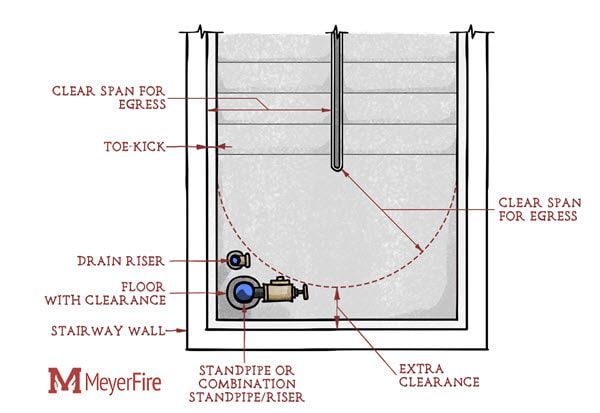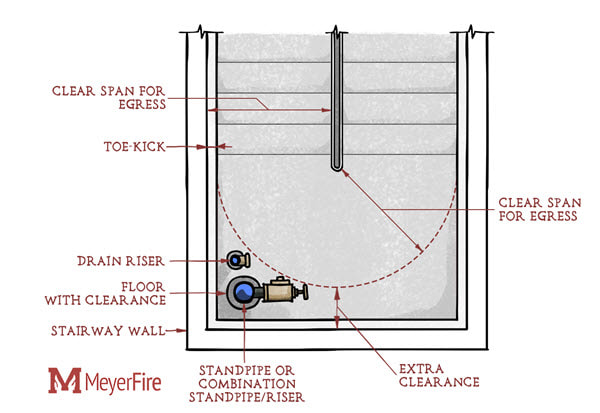Where in Ontario building code is this egress clearance of exit stairs prescribed?

-
Welcome to the new and improved Building Code Forum. We appreciate you being here and hope that you are getting the information that you need concerning all codes of the building trades. This is a free forum to the public due to the generosity of the Sawhorses, Corporate Supporters and Supporters who have upgraded their accounts. If you would like to have improved access to the forum please upgrade to Sawhorse by first logging in then clicking here: Upgrades
You are using an out of date browser. It may not display this or other websites correctly.
You should upgrade or use an alternative browser.
You should upgrade or use an alternative browser.
Egress clearance
- Thread starter sunyaer
- Start date
-
- Tags
- egress clearance exit stairs
The image can be found here as well:


Standpipe Hose Connections: Egress Clearance
Hope your week in fire protection is going well. Standpipes within stairs can be an important item to coordinate with the project architect, as the fix for the lack of coordination can be extremely...
www.meyerfire.com
bill1952
SAWHORSE
On egress, clearance, and stand pipes, some changes anticipated - approved by committee- in next edition of ANSI A117.1. Now, that MN ay be several years but still likely.
Yikes
Gold Member
I don’t know about the Ontario Building Code, but in the IBC landing dimensions are based on "direction of travel".
Because an intermediate landing essentially has people traveling in a 180 degree arc around the inner handrail, the direction of landing measurement constantly changes as it follows this arc of travel; it does not get measured straight.
1011.6 Stairway Landings
There shall be a floor or landing at the top and bottom of each stairway. The width of landings, measured perpendicularly to the direction of travel, shall be not less than the width of stairways served. Every landing shall have a minimum depth, measured parallel to the direction of travel, equal to the width of the stairway or 48 inches (1219 mm), whichever is less.
Because an intermediate landing essentially has people traveling in a 180 degree arc around the inner handrail, the direction of landing measurement constantly changes as it follows this arc of travel; it does not get measured straight.
1011.6 Stairway Landings
There shall be a floor or landing at the top and bottom of each stairway. The width of landings, measured perpendicularly to the direction of travel, shall be not less than the width of stairways served. Every landing shall have a minimum depth, measured parallel to the direction of travel, equal to the width of the stairway or 48 inches (1219 mm), whichever is less.
Inspector Gadget
Registered User
Depends on the calculated exit width. (Ie: is it code minimum, or wider due to exit width from occupancy per 3.4.3.2(1))
Code reference for limiting the obstruction to be no more than the exit width is 3.4.3.3(1).
FYI: I'm assuming a part 3 building given the standpipe.
Code reference for limiting the obstruction to be no more than the exit width is 3.4.3.3(1).
FYI: I'm assuming a part 3 building given the standpipe.
Should the code is 3.4.3.4.(1).?...
Code reference for limiting the obstruction to be no more than the exit width is 3.4.3.3(1).
FYI: I'm assuming a part 3 building given the standpipe.
Correct, the standpipe required by part 3.
Inspector Gadget
Registered User
NBC 2015 3.4.3.4 is headroom clearance. 3.4.3.3 is "exit width reduction."Should the code is 3.4.3.4.(1).?
Correct, the standpipe required by part 3.
Not sure of the OBC reference. (OBC 3.4.3.3 addresses exits from interconnected floor space, judging from a quick search.)
tmurray
SAWHORSE
You are both talking about the same code provision. Number is slightly different between versions.
Inspector Gadget
Registered User
Yep. Lesson for us all is to note which Code we're using - BCBC, ABC, OBBC, NBC. (Or, alors, le QBC.)You are both talking about the same code provision. Number is slightly different between versions.
I *think* the greatest difference is between OBC and the rest of 'em, no?
tmurray
SAWHORSE
Your exit width is set 3.4.3.2.(OBC) based on occupancy load and a few other factors. The stairs are by definition an exit. From the top right down to the discharge door. The width would need to be maintained throughout the stairs. Exceptions that allow things to protrude into the exit are contained in 3.4.3.4. (OBC).
If there is not an exception allowing something to reduce the exit width, no reduction would be permitted.
If there is not an exception allowing something to reduce the exit width, no reduction would be permitted.
Understood.Your exit width is set 3.4.3.2.(OBC) based on occupancy load and a few other factors. The stairs are by definition an exit. From the top right down to the discharge door. The width would need to be maintained throughout the stairs. Exceptions that allow things to protrude into the exit are contained in 3.4.3.4. (OBC).
If there is not an exception allowing something to reduce the exit width, no reduction would be permitted.
My question basically comes down to:
can the exit width be measured as the radius centered at the nose of the handrail shown in the picture given in my post? Which clause in OBC allows this measurement?
tmurray
SAWHORSE
There is nothing that would indicate if it must be measured as a semi-circle as shown, or rectangular.Understood.
My question basically comes down to:
can the exit width be measured as the radius centered at the nose of the handrail shown in the picture given in my post? Which clause in OBC allows this measurement?
Ultimately this would be up to the building official. When the code does not specify something like this, it would be up to their interpretation.
redeyedfly
Registered User
That is what I typically see on drawings. It allows for the standpipe to remain in the corner and not foul the egress path.Understood.
My question basically comes down to:
can the exit width be measured as the radius centered at the nose of the handrail shown in the picture given in my post? Which clause in OBC allows this measurement?
